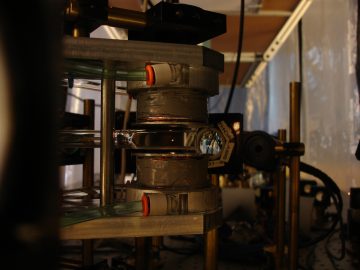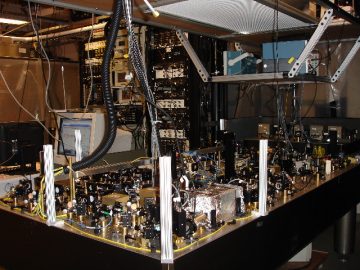Atom Based Quantum Sensors (ABaQuS)
Cold atoms make exquisite sensors for magnetic, electric, and gravitational fields. Gravity and accelerations are detected using matter-wave interfeomters. E&M fields can be measured by detecting the shifts of energy levels within the atom. For enhanced sensitivity to electric fields, high lying, so-called Rydberg, states can be used which, because the outer-most electron is very weakly bound to the atom, have an extremely large polarizability.
Cold atoms as a pressure and flux sensor
Cold atoms also constitute an ideal sensor for particle flux detection in an ultra-high vacuum environment. Very simply, the passage of a particle through the collision cross section of the atom is announced by the resulting collision recoil of (i.e. momentum transfer to) the cold atom. In this way, the sensor element is the atom itself – an ageless and unchanging object. The detection mechanism is based on a fundamental and unchanging property – the Van der Waals interaction potential between the sensor atom and the particles being measured. The idea is very simple yet extremely powerful as it provides a way to obtain an absolute measure of the particle flux or background density at pressures below 10$^{-6}$ Torr. Such absolute measurements are not presently possible with existing technology – ionization based gauges require calibration and therefore do not provide a reliable and absolute measure of vacuum. Preliminary theoretical and experimental work with argon indicated that this sensor technology works as expected. Extensive research has also been conducted to fully characterize the physics of cold-atom traps in order to realize the proposed sensor. Our next goal is to establish cold atom based sensors as a new international pressure and particle flux standard, and we have an ongoing collaboration with the PTB in Berlin (the National Standards Institute in Germany) and the U.S. National Institute of Standards and Technology in Gaithersburg to compare their existing orifice flow standard with a cold atom based standard at UBC.
This work is being done in collaboration with the group of James Booth from the British Columbia Institute of Technology. Our general goals include:
- the development of a portable and miniature laser cooling apparatus to serve as a mobile cold atom standard for comparisons at metrology groups worldwide.
- the detailed study of the physics of cold atomic ensembles inside of magnetic and magneto-optic traps.
- the detailed study of atom-atom and molecule-atom collision physics for the realization of a cold atom based pressure gauge.
- the detailed study of ion-atom and ion-molecule collision physics to understand the role of background collisions in the decoherence of quantum information stored in ion-based qubits.
Associated publications
W. Klassen, S. Ahmed, K. Pond Grehan, C. Hovde, K.W. Madison, R.R. Mammei, J.W. Martin, M. McCrea, T. Mohammadi, T. Momose, P. Opsahl, D. Ostapchuk
A magnetically silent optically pumped magnetometer for a neutron electric dipole moment experiment
The European Physical Journal C, xxxxx (2024), arXiv:2405.08696
Xuyang Guo, Kirk W. Madison, James L. Booth, and Roman V. Krems
Boundaries of universality of thermal collisions for atom-atom scattering
Phys. Rev. A 110, 063317 (2024), arXiv:2409.00273
James L. Booth, and Kirk W. Madison
Revising the Universality Hypothesis for Room-temperature Collisions
Phys. Rev. A 110, 052802 (2024), arXiv:2406.17065
Erik Frieling, Riley A. Stewart, James L. Booth, and Kirk W. Madison
Cross-calibration of atomic sensors for pressure metrology
AVS Quantum Sci. 6, 024404 (2024), arxiv:2312.15446
Avinash Deshmukh, Riley A. Stewart, Pinrui Shen, James L. Booth, and Kirk W. Madison
Trapped-particle evolution driven by residual gas collisions
Phys. Rev. A 109, 032818 (2024), arxiv:2310.04583
G. Arrowsmith-Kron et al.,
Opportunities for Fundamental Physics Research with Radioactive Molecules
Rep. Prog. Phys. 87 084301 (2024), https://arxiv.org/abs/2302.02165
Pinrui Shen, Erik Frieling, Katherine R. Herperger, Denis Uhland, Riley A. Stewart, Avinash Deshmukh, Roman V. Krems, James L. Booth, Kirk W. Madison
Cross-calibration of atomic pressure sensors and deviation from quantum diffractive collision universality for light particles
New Journal of Physics 25 053018 (2023) || arXiv:2209.02900
Rahul Rao
It’s pretty hard to measure nothing, but these engineers are getting close
Popular Science, Aug 8, 2022
Riley A. Stewart, Pinrui Shen, James L. Booth, Kirk W. Madison
Measurement of Rb-Rb van der Waals coefficient via Quantum Diffractive Universality
Phys. Rev. A 106, 052812 (2022) and arXiv:2208.12805
Pinrui Shen
Development of a Cold Atom Pressure Standard
Doctor of Philosophy, Dissertation – April 2022 || UBC-Circle Link to dissertation
Breakthrough development: a game-changing self-calibrating quantum sensor for vacuum measurement
BCIT News
Self calibrating quantum sensor a game changer for vacuum measurement
UBC PHAS News
Pinrui Shen, Kirk W. Madison, and James L. Booth
Realization of a universal quantum pressure standard
Metrologia [https://doi.org/10.1088/1681-7575/ab7170]
James L. Booth, Pinrui Shen, Roman V. Krems, Kirk W. Madison
Universality of quantum diffractive collisions and the quantum pressure standard
New Journal of Physics, https://doi.org/10.1088/1367-2630/ab452a || https://arxiv.org/abs/1905.02193
video abstract
Yue Shen
Determination of the Atom’s Excited-state Fraction in a Magneto-optical Trap
Master of Science, Thesis – October 2018 || UBC-Circle Link to thesis
Kais Jooya, Nam Musterer, Kirk W. Madison, and James L. Booth
Photon-scattering-rate measurement of atoms in a magneto-optical trap
Phys. Rev. A 88, 063401 (2013)
Magnus Haw, Nathan Evetts, Will Gunton, Janelle Van Dongen, James L. Booth, and Kirk W. Madison,
Magneto-optical trap loading rate dependence on trap depth and vapor density
JOSA B, Vol. 29, Issue 3, pp. 475-483 (2012)
James Lawrence Booth, David Erik Fagnan, Bruce George Klappauf, Kirk William Madison, Jicheng Wang
Method and device for accurately measuring the incident flux of ambient particles in a high or ultra-high vacuum environment
US13116982 ( Priority date : 2010-05-26)
Janelle Van Dongen, Chenchong Zhu, Dallas Clement, Gabriel Dufour, James L. Booth, and Kirk W. Madison,
Trap-depth determination using residual gas collisions
Phys. Rev. A 84, 022708 (2011)
David E. Fagnan, Jicheng Wang, Chenchong Zhu, Pavle Djuricanin, Bruce G. Klappauf, James L. Booth, and Kirk W. Madison,
Observation of quantum diffractive collisions using shallow atomic traps
Phys. Rev. A 80, 022712 (2009) || arXiv:0907.0506
J. L. Booth, J. Van Dongen, P. Lebel, B. G. Klappauf, and K. W. Madison,
Dual-channel amplification in a single-mode diode laser for multi-isotope laser cooling
J. Opt. Soc. Am. B 24, 2914-2920 (2007)


